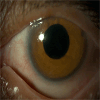Coexistence of Congenital Aniridia and Ptosis in a Patient with Neurofibromatosis Type I: A Case Report
- PMID: 40551856
- PMCID: PMC12185060
- DOI: 10.1159/000546420
Coexistence of Congenital Aniridia and Ptosis in a Patient with Neurofibromatosis Type I: A Case Report
Abstract
Introduction: Neurofibromatosis type 1 (NF1) is a genetic disorder caused by mutations in the NF1 gene on chromosome 17q11.2. The main ocular manifestations include Lisch nodules, optic pathway gliomas, and plexiform neurofibromas, all of which can potentially impair visual function. Despite the numerous documented ocular manifestations of NF1, congenital aniridia has never been previously reported. Aniridia is a rare congenital disorder primarily associated with mutations in the PAX6 gene, leading to iris hypoplasia, corneal pannus, cataracts, and glaucoma. PAX6-negative aniridia has been described in some cases, suggesting alternative genetic mechanisms. Additionally, a minority of patients with aniridia exhibit ptosis. We present a unique case of a 50-year-old woman with NF1, exhibiting bilateral congenital aniridia and ptosis, without PAX6 mutations.
Case presentation: A 50-year-old woman diagnosed with NF1 presented with bilateral congenital ptosis and aniridia. Genetic analysis confirmed the presence of the NF1 c.4537C>T variant but was negative for PAX6 mutations. Ophthalmological examination revealed total aniridia, cataract, ptosis, and pendular nystagmus. The patient underwent levator muscle resection for ptosis correction and cataract extraction with implantation of an intraocular lens with an iris prosthesis. Histopathological analysis of the levator muscle showed atrophic changes in the absence of neurofibromatous infiltration.
Conclusion: This case represents the first documented instance of bilateral congenital aniridia in a patient with NF1. The absence of PAX6 mutations suggests an alternative genetic mechanism or a novel NF1 phenotype. This highlights the importance of thorough ophthalmologic and genetic evaluation in NF1 patients, integrating a multidisciplinary approach to identify atypical phenotypic associations and ensure optimal management.
Keywords: Aniridia; Cataract surgery; Genetics; Neurofibromatosis; Ptosis.
© 2025 The Author(s). Published by S. Karger AG, Basel.
Conflict of interest statement
The authors have no conflicts of interest to declare.
Figures
Similar articles
-
Surgical interventions for bilateral congenital cataract in children aged two years and under.Cochrane Database Syst Rev. 2022 Sep 15;9(9):CD003171. doi: 10.1002/14651858.CD003171.pub3. Cochrane Database Syst Rev. 2022. PMID: 36107778 Free PMC article.
-
Clinical signs and genetic evaluation of patients with neurofibromatosis type 1 with and without optic pathway gliomas in a center in Turkey.Childs Nerv Syst. 2024 Feb;40(2):511-515. doi: 10.1007/s00381-023-06061-5. Epub 2023 Jul 4. Childs Nerv Syst. 2024. PMID: 37401974
-
Intraocular lens optic edge design for the prevention of posterior capsule opacification after cataract surgery.Cochrane Database Syst Rev. 2021 Aug 16;8(8):CD012516. doi: 10.1002/14651858.CD012516.pub2. Cochrane Database Syst Rev. 2021. PMID: 34398965 Free PMC article.
-
Pathogenesis and treatment of a giant occipital bone defect with meningoencephalocele in an NF1 child: case report and review of the literature.Childs Nerv Syst. 2024 Jan;40(1):27-39. doi: 10.1007/s00381-023-06232-4. Epub 2023 Nov 23. Childs Nerv Syst. 2024. PMID: 37993698
-
Short-read whole genome sequencing identifies causative variants in most individuals with previously unexplained aniridia.J Med Genet. 2024 Feb 21;61(3):250-261. doi: 10.1136/jmg-2023-109181. J Med Genet. 2024. PMID: 38050128 Free PMC article.
References
-
- Kinori M, Hodgson N, Zeid JL. Ophthalmic manifestations in neurofibromatosis type 1. Surv Ophthalmol. 2018;63(4):518–33. - PubMed
-
- Hoyt CS, Billson FA. Buphthalmos in neurofibromatosis: is it an expression of regional giantism? J Pediatr Ophthalmol. 1977;14(4):228–34. - PubMed
-
- Morales J, Chaudhry IA, Bosley TM. Glaucoma and globe enlargement associated with neurofibromatosis type 1. Ophthalmology. 2009;116(9):1725–30. - PubMed
Publication types
LinkOut - more resources
Full Text Sources
Research Materials
Miscellaneous




